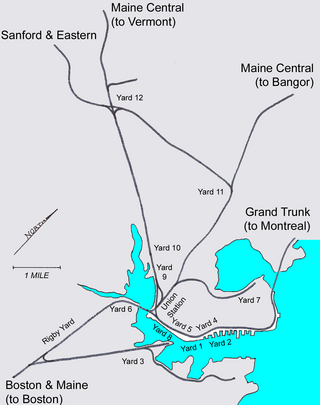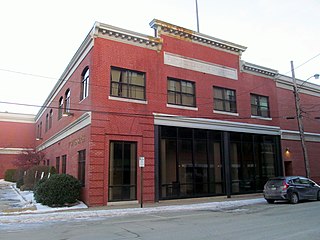
Westbrook is a city in Cumberland County, Maine, United States and a suburb of Portland. The population was 20,400 at the 2020 census, making it the fastest-growing city in Maine between 2010 and 2020. It is part of the Portland–South Portland–Biddeford, Maine metropolitan statistical area.

Windham is a town in Cumberland County, Maine, United States. The population was 18,434 at the 2020 census. It includes the villages of South Windham and North Windham. It is part of the Portland–South Portland–Biddeford, Maine Metropolitan Statistical Area.

Sebago Lake (Sih-Bay-Goh) is the deepest and second-largest lake in the U.S. state of Maine. The lake is 316 feet (96 m) deep at its deepest point, with a mean depth of 101 feet (31 m). It is possible that Sebago is the deepest lake wholly contained within the entire New England region, although some sources say that Vermont's Lake Willoughby is slightly deeper. Along with Lake Champlain, Sebago is one of the only lakes in the area that does not consistently freeze solid during the winter months, with total ice cover only occurring for a short period of time every few winters. Sebago covers about 45 square miles (117 km2) in surface area, has a length of 14 miles (23 km) and has a shoreline length of roughly 105 miles (169 km). The surface is around 270 feet (82 m) above sea level, so the deep bottom is below the present sea level. It is in Cumberland County, and bordered by the towns of Casco, Naples, Raymond, Sebago, Standish and Windham. The seasonally occupied town of Frye Island is on an island in the lake. Sebago Lake and the surrounding area is known for its erratic and sudden changes in weather during all seasons, likely due to its proximity to the Atlantic Ocean and to Mt. Washington, a very notorious extreme weather hotspot. The name comes from the Abenaki sobagoo, meaning "it is the sea" or "it resembles the sea".

The St. Lawrence and Atlantic Railroad, known as St-Laurent et Atlantique Quebec in Canada, is a short-line railway operating between Portland, Maine, on the Atlantic Ocean, and Montreal, Quebec, on the St. Lawrence River. It crosses the Canada–US border at Norton, Vermont, and Stanhope, Quebec, and is owned by short-line operator Genesee & Wyoming.

The Sandy River and Rangeley Lakes Railroad (SR&RL) was a 2 ft narrow gauge common carrier railroad that operated approximately 112 miles (180 km) of track in Franklin County, Maine. The former equipment from the SR&RL continues to operate in the present day on a revived, short segment of the railway in Phillips, Maine.

The Bridgton and Saco River Railroad (B&SR) was a 2 ft narrow gauge railroad that operated in the vicinity of Bridgton and Harrison, Maine. It connected with the Portland and Ogdensburg Railroad from Portland, Maine, to St. Johnsbury, Vermont, near the town of Hiram on the Saco River.

The Monson Railroad was a 2 ft narrow gauge railway, which operated between Monson Junction on the Bangor and Aroostook Railroad and Monson, Maine. The primary purpose of this railroad was to serve several slate mines and finishing houses in Monson. According to the Scientific American of 17 May 1890, it was the smallest railroad in the United States.

The Presumpscot River is a 25.8-mile-long (41.5 km) river located in Cumberland County, Maine, United States. It is the main outlet of Sebago Lake. The river provided an early transportation corridor with reliable water power for industrial development of the city of Westbrook and the village of South Windham.

The Portland Terminal Company was a terminal railroad notable for its control of switching (shunting) activity for the Maine Central Railroad (MEC) and Boston & Maine (B&M) railroads in the Maine cities of Portland, South Portland, and Westbrook.

The Cumberland and Oxford Canal was opened in 1832 to connect the largest lakes of southern Maine with the seaport of Portland, Maine. The canal followed the Presumpscot River from Sebago Lake through the towns of Standish, Windham, Gorham, and Westbrook. The Canal diverged from the river at Westbrook to reach the navigable Fore River estuary and Portland Harbor. The canal required 27 locks to reach Sebago Lake at an elevation of 267 feet (81 m) above sea level. One additional lock was constructed in the Songo River to provide 5 feet (1.5 m) of additional elevation to reach Long Lake from Sebago Lake. Total navigable distance was approximately 38 miles (61 km) from Portland to Harrison at the north end of Long Lake. A proposed extension from Harrison to Bear Pond and Tom Pond in Waterford would have required three more locks on the Bear River, but they were never built.

The Mountain Division is a railroad line that was once owned and operated by the Maine Central Railroad (MEC). It stretches from Portland, Maine on the Atlantic Ocean, through the Western Maine Mountains and White Mountains of New Hampshire, ending at St. Johnsbury, Vermont in the Northeast Kingdom. The line was abandoned in 1983 by MEC's successor, Guilford Transportation Industries (GTI). Guilford retained a stub between Portland and Westbrook. A section in New Hampshire remains in use by heritage railway Conway Scenic Railroad.

South Windham is a census-designated place (CDP) in the town of Windham in Cumberland County, Maine, United States. The population of the CDP was 1,374 at the 2010 census. Prior to 2010, South Windham was part of the Little Falls-South Windham census-designated place.
The Worcester, Nashua and Rochester Railroad was a railroad line that was to link the city of Worcester, Massachusetts, to the city of Portland, Maine, via the New Hampshire cities of Nashua and Rochester, by merging several small shortline railroads together.

The Somerset Railroad was built to serve Kennebec River communities and later extended through timberlands to a large wooden Victorian era destination hotel on Moosehead Lake. The railway became part of the Maine Central Railroad in 1911; and a portion remained in intermittent operation by Pan Am Railways until 2013.
Oriental Powder Company was a gunpowder manufacturer with mills located on the Presumpscot River in Gorham and Windham, Maine. The company was one of the four largest suppliers to Union forces through the American Civil War.

Gorham is a town in Cumberland County, Maine, United States. The population was 18,336 at the 2020 United States Census. In addition to its urban village center known as Gorham Village or simply "the Village," the town encompasses a number of smaller, unincorporated villages and hamlets with distinct historical identities, including South Gorham, West Gorham, Little Falls, White Rock, and North Gorham. Gorham is home to one of the three campuses of the University of Southern Maine. In 2013, Gorham was voted second-best town in Maine after Hampden by a financial website.
The Eagle Lake and West Branch Railroad was a forest railway built to transfer pulpwood between drainage basins in the Maine North Woods. The railroad operated only a few years in a location so remote the steam locomotives were never scrapped and remain exposed to the elements at the site of the Eagle Lake Tramway. Its tracks were located in Penobscot County and Piscataquis County.
The Seboomook Lake and Saint John Railroad was a forest railway built to transfer pulpwood between drainage basins in the Maine North Woods. The railroad was built slowly in preparation for anticipated pulpwood harvesting, but onset of the Great Depression caused the railroad to be dismantled when harvesting plans were delayed.

The Portland–Lewiston Interurban (PLI) was an electric railroad subsidiary of the Androscoggin Electric Company operating from 1914 to 1933 between Monument Square in Portland and Union Square in Lewiston, Maine. Hourly service was offered over the 40-mile (64 km) route between the two cities. Express trains stopping only at West Falmouth, Gray, New Gloucester, Upper Gloucester and Danville made the trip in 80 minutes, while trains making other local stops upon request required 20 minutes more. The line was considered the finest interurban railroad in the state of Maine.

Forest Paper Company was a pulp and paper mill on the Royal River in Yarmouth, Maine, United States, which was in business between 1874 and 1923. It was the first of its kind in New England. In 1909, it was the largest such mill in the world, employing 275 people. It produced 80 tons of poplar pulp each day.



















